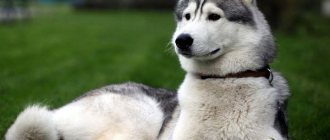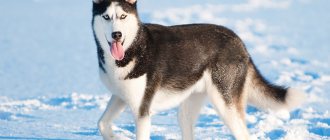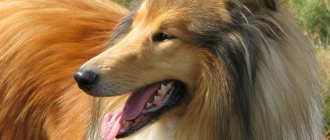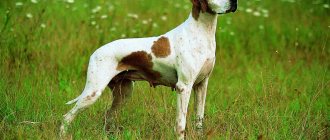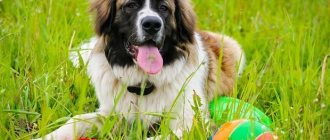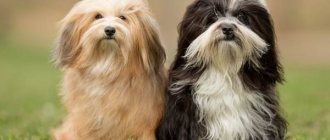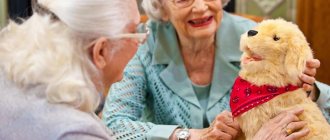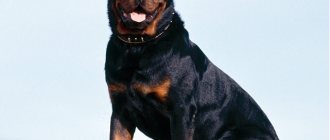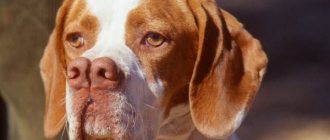A dog's conformation is a description of the animal's appearance. These are evaluation criteria, descriptions of body parts. Each of the dog's articles performs a specific function. Therefore, it is important for specialists to establish the relationship between the appearance of body parts and their functionality. This helps improve the quality of the breed.
A purebred dog must meet the criteria
The dog's conformation is the purpose of selection
Each breed has its own standards for the appearance of a dog. Specialists ensure that changes do not go beyond established boundaries. The health of the dog and the preservation of its main qualities depend on this.
Thus, the main goal of the exterior is to maintain certain standards and improve the breed. Other goals - maintaining health and beneficial qualities depend on the main criterion. A manual with a description of the articles and regulations is necessary for judges and experts at exhibitions.
Important! Representatives of different breeds will have different exterior features.
Alaskan Malamute
It is also a very ancient breed and is regularly confused with the Husky. But the Malamute has a completely different build and color. This is a very hardy sled dog, whose place is in the Far North. Height at the withers is 63-58 cm.
Up to three years old, Malamutes are little devils with horns. Their restless nature cannot calm down even after a very long walk with loads. and they, like huskies, selflessly dig holes. Therefore, the owner needs to constantly deal with it. And only after three years the dog becomes calmer.
Malamute is very sociable and good-natured. But at the same time, he is very independent, and sometimes decides for himself what to do. Such a dominant needs strict training. If a Malamute becomes swollen from boredom, it begins to destroy everything around it, so you need to give it a good physical load.
The breed gets along well with other domestic animals, but outside the home their hunting instinct awakens, and other animals often become the dog’s prey.
Malamutes also have an excellent memory. This is worth considering, especially if the pet has done something wrong and you want to punish it. The dog will definitely remember the insult, and if necessary, may even take revenge.
Video: Alaskan Malamute
Exterior concept
In dog breeding, this name refers to a system of patterns for assessing the appearance of a dog. With its help, specialists can identify deviations from generally accepted standards. Conformation is a rating system that takes into account the diversity of breeds.
In addition, the criteria explain the features and relationships between the dog’s characteristics. But this is the concept of a general exterior. There is also a private one that considers each breed separately. All breeds are different from each other, and this is due to the fact that they were bred for different purposes.
The exterior is assessed by professionals
Belgian Shepherd
This is a beautiful and active service dog, whose height ranges from 55-60 cm. There are 4 subspecies of Belgians, and they all differ from each other, although in general one cannot help but notice the general similarity.
Tervuren
characterized by impulsiveness. His lively character requires constant communication with one owner of his choice. Whatever idea you propose to the dog, the idea will be picked up with all readiness.
Tervuren
Laekenois
quite polar. Either they are cheerful and playful, or they can turn away with an absent look and lie down to rest. But if necessary, the dog shows excellent guard qualities, and if necessary, it boldly enters into battle. Laekenois needs exercised walks.
Laekenois
Malinois
They love communication with their owner, but at the same time they are distinguished by strict obedience among all Belgian Shepherds. This is a very balanced dog for whom you will be the center of her universe.
Malinois
Groenendael
It has remarkable watchdog and herding qualities. He loves his master without regard and is somewhat wary of strangers. like other Belgians, he needs regular exercise.
The Groenendael
Belgian can make friends with other pets if he has grown up with them from puppyhood. But even in this case, it is better to keep all rodents and even cats away.
I cannot recommend the Belgian to a beginner, because his thirst for freedom is too indomitable, and this requires a firm hand and considerable experience.
Video: Belgian Shepherd
Stati dogs
Dog handlers distinguish 52 parts of the body, which are called “articles”. It is they who determine the exterior, on the basis of which they give marks in competitions, and determine the deviation from the norm. You can see all the characteristics of the dog on the diagram. They are grouped into large groups:
- Scull. Specialists pay attention to the frontal part, nasal and ear areas. Dog handlers are also interested in “stop” – this is the angle of transition between the frontal and nasal areas. Experts pay attention to less pronounced parts - cheekbones, parotid, cheek and chewing. Not only the shape, size, but also the color of certain anatomical parts are important.
- The head is an important criterion for assessing the appearance of a dog. Pay attention to size, shape, proportions. Conventionally, the head is divided into two main sections - posterior and anterior. Dog trainers look at the proportions of the parts to determine compliance with breed standards.
- The neck affects head posture because it regulates the dog's center of gravity. The ability to maintain balance depends on this. The position of the neck changes according to the phase of movement.
- Forelegs - evaluate their length, symmetry, color, shape of pads and length of claws.
- Dog Chest – Different breeds will have different lengths, depths and widths.
- The hind limbs differ from the forelimbs in their larger size and massiveness. The strength of the pet's jerk when jumping depends on their structure. For example, like a Labrador.
- Tail - its length, color, shape will be different in all breeds. This is also an important criterion for assessing a dog’s exterior.
In some breeds, slight deviations from the norm in one or more criteria are acceptable. Often breeders cross breeds to enhance certain qualities. The result is a new variety, for which their own appearance criteria are developed.
Each breed has its own criteria
American Staffordshire Terrier
The fame of this dog runs ahead of her. And all because Amstaffs can be both complacent, good-natured people and excellent companions, and warriors without fear or reproach.
The breed was bred to be a protector for the family , but its intelligence and physical characteristics were rated a little in the wrong direction. Therefore, Staffordshire is a frequent participant in dog fights. The staff rushes at the enemy instantly, practically without barking or growling, and few will be able to stop him.
By the way, staff is great for keeping in an apartment. Medium size and short hair usually do not cause owners much trouble. Well, except that his mobility can sometimes be confusing: how can you move so quickly with such a physique?
Amstaff training is not for amateurs. And although there are cases when a dog understands its owner without words, training such a serious dog requires a special approach. He should not be treated roughly and anger should not be cultivated in his character. At the same time, it is quite difficult to piss off a Staffordshire, but if this happens, it will not seem like much.
The American Staffordshire Terrier will gladly take part in all games; it gets along well with children, but it is still not worth leaving it with a very small child.
Video: American Staffordshire Terrier
The structure of dog articles and the main deviations from the norm
One of the main breed characteristics is the head. Its appearance and shape are inherited. The basis of the head is the skull, the shape and size of which do not depend on the conditions of keeping and feeding the animal. This body consists of the bones of the cranial and facial parts. The appearance of the head depends on their proportions.
On a note! Based on the dog's occipital protuberance, dog handlers determine the strength of the animal's jerk.
The most variable part of the head are the jaws and facial bones. The relationship of the jaws affects not only the shape of the muzzle, but also the bite. For a dog handler, the size and shape of the nose are important. By its appearance, you can determine the health status of the animal. A black, wet and cold nose is characteristic of a healthy dog, while a dry, warm and cracked nose can be a sign of illness.
Important! A sleeping dog's nose is always warm.
Another distinguishing feature of the breed is the ears. They differ in:
- length;
- location on the head;
- tip shape;
- development of subcutaneous tissue of the auricle.
Each breed has strict regulations that determine the acceptable ear shape. The erect ears have tips pointing upward and form a right angle with the frontal lobe of the head. If the auricle is located below the line of the eyes or at their level, these are low-set ears and vice versa.
Floppy ears are common in dogs that are used in water. They are considered according to the same parameters as standing ones.
Important! Previously, there was cupping, and many considered this procedure useful. But now bills have been passed prohibiting its implementation.
In the exterior, a thoroughbred criterion is the eyes. It is preferable when the dog has a dark iris. Light and almost colorless eyes are most often considered a deviation from the norm. Also disadvantages are the small size of the eyes, their blindness, a pronounced third eyelid, and eversion of the eyelids. All this can lead to serious eye diseases, so it is important to show the animal to an ophthalmologist in a timely manner.
Deviations are the absence of teeth and irregular bite shape. The correct bite depends on the purpose of the dog. In addition, pay attention to the size and appearance of the teeth.
On a note! The skeleton of the animal is also important for the exterior. Its size and coat color depend on the specific breed. One of the articles is the back. It should be wide, strong and straight.
Limbs should be the same length and symmetrical. In this case, the hind legs should be more powerful, with more developed muscles. If one paw is longer than the other, then this is a reason to contact the veterinarian, because this is a deviation from the norm. Each breed has its own criteria for limb length. Paws are the key to a dog’s comfortable life. If the owner notices abnormalities in the pet's gait, it is necessary to contact a specialist.
Important! The dog's metatarsus provides stability during sudden movements.
The tail is determined by the standards of each breed. This part of the body helps the dog maintain balance and control its center of gravity. The tail is an indicator of the animal's mood, temperament and health.
Stati dogs
English Mastiff
A real giant in its class. The height of dogs starts from 70-75 cm at the withers, but the breed is endowed with a very good-natured disposition; it is quite difficult to anger them. And this in no way fits with their glorious military past - mastiffs are not fools to lie on the sofa, and if they are together with their owner, it’s generally wonderful. Real imposingness of English aristocrats!
The most interesting thing is that mastiffs really love to be close to their owner. It can be a powerful Herculean hug, and sometimes the dog imagines itself as a kitten and tries to climb onto your lap. Need I say that the worst punishment for this dog is loneliness?
Strange, right? It seems to be a service dog, and not some kind of sissy. But in the good heart of a mastiff there is also room for mistrust of strangers. The dog is unlikely to be the first to attack, but driving the enemy into a corner is always welcome.
The mastiff exhibits such qualities when properly raised. If the owners instill kindness and affection in the dog, then that’s how it will be. But if you touch on your combat past, you will have a fearless legionnaire at your disposal. Are you the only one who needs a dog like this?
Despite the fact that the mastiff is an avid homebody, he still needs walks. He won’t rush around like crazy after a stick, but a leisurely, sedate step is just his gait.
But training will bring many surprises. Mastiffs are solid “C” students, but not because they lack intelligence. This is a large, self-sufficient and stubborn dog and with all its appearance: “Why do I need training, I’d rather lie on the sofa.” Therefore, you need to be persistent here.
You should not get a mastiff if the owners are away from home for a long time. And if there is a very small child in the family, it is better to think about a different breed, since the impressive carcass of a mastiff can become a source of injury.
Video: English Mastiff
Biomechanical model - the basis of the exterior
The biomechanical model is the general patterns of dog development. Thanks to this approach, it is possible to view the exterior from all sides. This is the proportionality of all parts, sizes, shapes. A major contribution to the development of this concept was made by E.L. Jerusalem.
The use of a biomechanical model makes it possible to evaluate elite dog breeds and their compliance with parameters. It also helps to strengthen certain qualities in order to bring the dog to the desired destination, and affects the result of training.
Using a biomechanical model
It is used in the following areas:
- to conduct an examination of compliance with breed standards;
- to evaluate the result of crossing breeds.
This model applies to almost all breeds. The exception is crossing to improve certain qualities. The biomechanical principle is the basis for assessing the results of crossbreeding.
Purebred dogs participate in exhibitions
Doberman
If someone says that the Doberman is the most beautiful service dog, then I would probably agree. This breed surprisingly combines the strongest guarding qualities and intelligence with deer grace and strength.
If someone says that Dobermans are vicious and inadequate, then first of all you need to get to know their owners (or maybe not). The Doberman becomes angry and crazy when he is specially trained to do so. This absolutely cannot be done, since the dog’s high intelligence will evaluate the situation in its own way, and it will be difficult to cope with it.
With proper upbringing, the Dober makes a wonderful friend for adults and a caring nanny for children and other pets. The dog is easy to train (after all, it is one of the smartest breeds), but first the dog needs to see the alpha in its owner. Only then can unquestioning obedience be guaranteed.
The Doberman, especially the young one, is a mega-active dog. He needs long walks with good exercise. But sometimes, even if his tongue is on his shoulder from fatigue, when he hears the command “come to me,” and realizing that he will be led home, he rushes away as fast as he can. And it's quite difficult to catch him. To prevent such incidents from happening, regularly call him to you while walking. And this applies to all dogs with a hot temperament.
The Doberman is a wonderful companion and bodyguard who will vigilantly monitor the safety of you and your family.
Video: Doberman
Examples of such criteria
What breeders pay attention to:
- the topline principle - it is used to evaluate how the limbs and back function;
- head size - this indicator is necessary to distinguish between sex differences;
- angles of the joints of the limbs - a criterion needed to assess the dog’s movement;
- the condition of the dentition, the color of the gums is a factor affecting the quality of digestion;
- The density of the overall color is an indicator of the intensity of all life processes of the dog.
These criteria are used by experts to evaluate all breeds. They allow you to monitor your pet’s health and, if necessary, make an appointment with a veterinarian based on them.
Moscow watchdog
As the name implies, the breed belongs to the category of guard dogs. Her ancestors - Caucasian Shepherds and St. Bernards - cannot be called unbalanced, and the “Muscovite” is exactly the same.
However, the greater the proportion of St. Bernard blood, the calmer and more imposing the dog will be . Conversely, if the Caucasian Shepherd dog is dominant in the blood, the dog will be more vigilant and distrustful.
The watchdog gets along well with children and pets, and is at least indifferent to strangers, and at most disapproving. Since the dog is large, it should not be left with very young children, since their weight categories are incompatible.
Training of the Moscow watchdog should begin from the first days of its appearance in the house. Even a small puppy will not mind testing your authority, so you need to raise your dog in a strict “dos and don’ts” dimension and never deviate from the chosen course. Teenagers can show off and deliberately disobey commands. You need to prove your authority to the dog, otherwise the “Muscovite” will be the owner.
Video: Moscow watchdog
Exterior of a dog using the example of a German Shepherd
This breed was an ideal example of the implementation of the biomechanical model. But experts continued to perfect the result. The German Shepherd is one of the most popular breeds in the world; its qualities are actively used in various fields. Therefore, the exterior has undergone significant changes. The type of her constitution, her appearance and her qualities have changed.
Conformation helps improve the breed
Changes in the exterior of the German Shepherd during the selection process
Initially, representatives of this breed had an elongated body. But gradually the upper part became raised, the chest became pronounced, and the angles of the hind legs changed. All these transformations fit into the new breed standards.
On a note! Breeders paid a lot of attention to changing the chest. This opened up more opportunities for the German Shepherd. Thanks to such changes, the dog can develop greater speed and has increased endurance.
Only a specialist can correctly assess a dog’s exterior. He must not only have the appropriate education, but also the ability to look at the pet from a professional point of view. The specialist must have a good knowledge of anatomy, breed standards, general and specific exteriors.
Siberian Husky
The Siberian Husky is similar in appearance to the Malamute, but smaller. The breed was bred by breeders; previously they were used by the tribes of the north as hunting and sledding dogs, but with heavy loads. The name comes from the word “eski”, as the tribes of the Arctic were called. The peculiarity of the breed is that they are able to transport heavy loads over long distances. They also have blue eyes, thick fur and weigh up to 30 kg. At the moment the pet is used as a companion and circus dog for shows.
